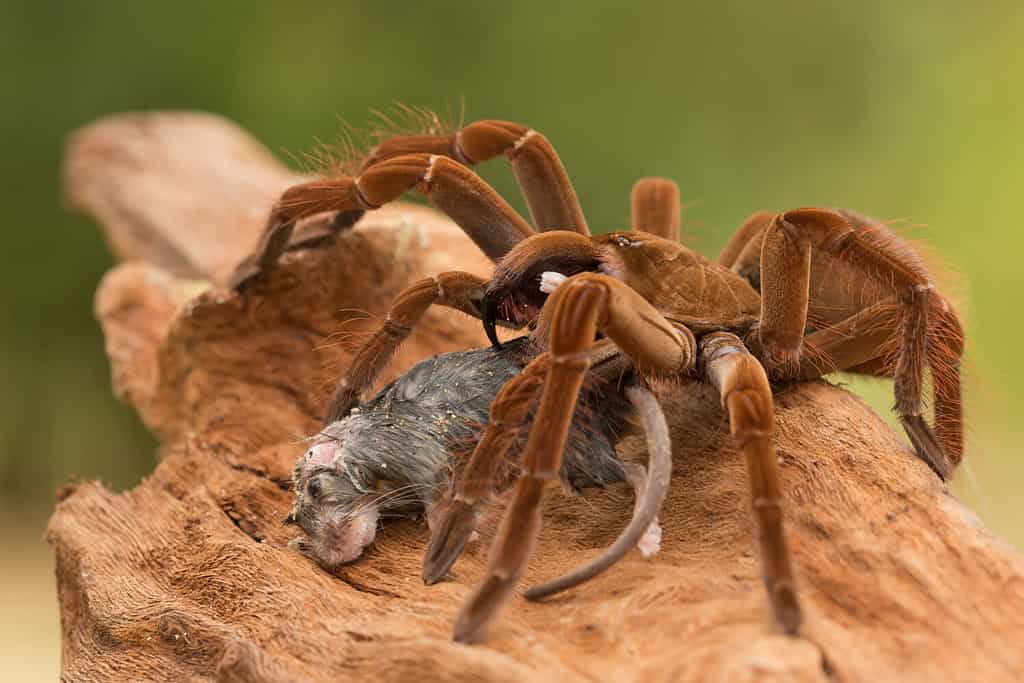Spiders are some of the most intriguing animals on the planet. Everything they do seems mysterious and strange to humans. Because of this, many humans fear arachnids and label them as creepy. They are filled with unique traits and superpowers that are often overlooked. A spider’s strength can hang upside down to construct a web of silk and launch through the air to snag a fly in midair. That takes strength. How strong are spiders when compared to humans or animals?
Spider Strength

A spider’s strength is incredible, considering how small and frail they are up against some of the prey they catch.
©Milan Zygmunt/Shutterstock.com
Without getting too far into explanations, spiders can lift roughly ten times their weight! That is considerable if you think about lifting ten people your weight. Keep in mind it’s just an average. Some spider’s strength is even more impressive since they can lift 170 times their weight! The strongest humans in the world can lift nearly three times their body weight, and only three people have fallen into that category ever. In the lands of scientific research, scientists debate quite a bit about what a spider can lift and carry. To figure out exactly how much each type of spider can raise, we use a formula called Strength-to-Weight Ratio. High strength ratios are typically seen in tiny, very light creatures. The bigger the beast, the harder it is to lift more significant items. Look at side-to-side comparisons of a spider’s strength against humans and other animals.
Spiders can lift 200 times their body weight, but the average for all types of spiders is eight times their body weight.
| Type of Animal | Lifting Strength | Who’s the Winner Against a Spider? |
| Human | They can carry up to 50 times their body weight but, on average, can lift 10 – 50 times. | Spiders win! |
| Ant | Can suffocate up to one time of its 552-pound body weight | Spiders win! |
| Elephant | Can carry up to 1/10th of its body weight at 1300 pounds | Spiders win! |
| Anaconda | They can carry up to 1.5 times their body weight of 2000 pounds. | Spiders win! |
| Musk Ox | They can carry up to 1141 times their body weight. | Spiders win! |
| Dung Beetle | Dung Beetles wins! | Rhinoceros Beetle |
| They can carry up to 850 times their body weight | They can carry up to 10 times their body weight of 4,400 pounds. | Rhinoceros Beetles win! |
| Gorilla | They can carry up to four times their body weight while in flight. | Spiders win! |
| Eagle | They can carry up to two times their body weight up a tree. | Spider wins! |
| Tiger | Can carry up to two times their body weight up a tree. | Spiders win! |
The Secrets of a Spider’s Silk

Spider silk is a material scientists are still trying to replicate synthetically.
©SakSa/Shutterstock.com
Silk is one of the most robust materials regarding a spider’s strength. It’s even more potent than Kevlar, thread for thread. Spider silk is ten times as strong as Kevlar on average, and because of this, it is one of the most desired materials to duplicate on Earth. Spider silk is so strong that the medical industry has tried to copy it for a long time. The Darwin bark spider has the strongest silk compared with all other spiders.
Think of it this way: spider silk is so strong that it can catch bats, birds, giant moths, cicadas, and other large animals, and the web isn’t even messed up. It isn’t just the silk that makes this occur; it is also how they weave their webs into intricate designs, as seen with the orb weavers. Some other spiders use their webbing differently. Jumping spiders use their silk to cast safety lines, so if their jump doesn’t take them where they want to go, they will be connected to a safe spot to climb back up. Trapdoor spiders use their silk to line the inside of their tunnels and hold them from caving in. They also fasten doors to the outside of their burrows that are held together by dirt, sticks, leaves, and silk.
Don’t Call a Spider Weak

Spiders are unique in so many different ways.
©iStock.com/Henrik_L
Spiders’ strength is out of this world compared to most animals, and they show us this in many ways. Some spiders, such as wolf spiders, carry their eggs in their mouths until they are close to hatching. Then, when the eggs hatch, hundreds of spiderlings climb aboard their mother’s back and ride along for weeks.
Jumping spiders can jump at least ten times their body length with the force and strength of their legs. Can you imagine jumping 60 feet if you are six feet tall? On average, a human performing the long jump can only jump 8 to 10 feet. They can also do so from a standing position and catch an insect weighing many times their weight in midair. It would be tough not to find that as impressive.
Animals, like spiders, are awe-inspiring in many ways, even those that aren’t as popular to the average human. A spider’s strength is comparable to that of a real-life superhero. Be glad they aren’t the size of elephants because they would see humans as prey!
The photo featured at the top of this post is © Dmytro Khlystun/Shutterstock.com
Thank you for reading! Have some feedback for us? Contact the AZ Animals editorial team.







